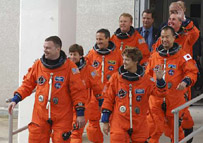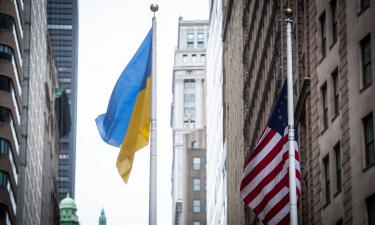Shuttle crew arrives in Florida for launch
Space shuttle Discovery's crew of seven arrived at the Kennedy Space Center on Tuesday for this weekend's launch, a day after a top NASA engineer who praised his colleagues for voicing doubts about the wisdom of going ahead with the flight was removed from his job.

Charlie Camarda said in an e-mail to colleagues Monday that he was forced out as chief of the engineering directorate at the Johnson Space Center and that he had been offered another position working for NASA's Engineering and Safety Center.
He did not offer a specific reason for his removal, and a NASA spokesman would not comment on Camarda's departure.
Discovery is scheduled to lift off on Saturday. At a high-level flight-readiness meeting earlier this month, NASA's top safety and engineering officers recommended against a launch until further design changes are made to the external fuel tank to prevent foam from breaking off and hitting the shuttle the very problem that doomed Columbia in 2003, reports AP.
But if Discovery is seriously damaged at launch and the shuttle crew is sent to shelter aboard the space station, Nasa chief Michael Griffin has said he would consider ending the quarter-century-old shuttle program.
In that case, Griffin said on June 17, "I would be moving to shut the programme down... I think, at that point, we're done."
That would make it virtually impossible to finish building the space station as currently designed or repair the Hubble. It would also leave the United States with no homegrown way to get humans to space until the next generation of vehicles is ready, probably around 2011.
Nasa's human space flight program has been under a cloud since the shuttle Columbia disintegrated over Texas on February 1, 2003, killing all seven aboard, reports Independent Online.
According to Hartford Courant, Bryan O'Connor, the safety officer, was overruled by NASA Administrator Michael Griffin, who made the ultimate decision in favor of liftoff. Mr. O'Connor, a former shuttle commander, later said he was comfortable with the decision to launch and didn't think the astronauts were in danger. There is a backup plan for the crew to take refuge in the international space station and be rescued if foam should damage the craft as it did on the fatal flight of Columbia in 2003.
Extensive modifications have been made to the shuttle fuel tank since Columbia broke apart 16 minutes from home. But during last summer's launch of Discovery, the first since the tragedy in which seven astronauts died, pieces of foam broke off again. Fortunately, there were no fatal consequences. Why tempt fate?
The accident report following the Columbia disaster ripped NASA for miscommunication and a failure to listen to recommendations that put the crew in peril. The report said NASA was more concerned with the threat to the schedule than the threat to the spacecraft.
This sounds like deja vu, all over again.
O.Ch.
Subscribe to Pravda.Ru Telegram channel, Facebook, RSS!





